 W
WAudio forensics is the field of forensic science relating to the acquisition, analysis, and evaluation of sound recordings that may ultimately be presented as admissible evidence in a court of law or some other official venue.
 W
WAn audio letter is an audio recording sent by postal mail to a recipient. The practice was more common when charges for long-distance telephone services were higher and before the widespread use of the Internet.
 W
WMastering, a form of audio post production, is the process of preparing and transferring recorded audio from a source containing the final mix to a data storage device, the source from which all copies will be produced. In recent years digital masters have become usual, although analog masters—such as audio tapes—are still being used by the manufacturing industry, particularly by a few engineers who specialize in analog mastering.
 W
WIn sound recording and reproduction, audio mixing is the process of optimizing and combining multitrack recordings into a final mono, stereo or surround sound product. In the process of combining the separate tracks, their relative levels are adjusted and balanced and various processes such as equalization and compression are commonly applied to individual tracks, groups of tracks, and the overall mix. In stereo and surround sound mixing, the placement of the tracks within the stereo field are adjusted and balanced. Audio mixing techniques and approaches vary widely and have a significant influence on the final product.
 W
WAn audio tour or audio guide provides a recorded spoken commentary, normally through a handheld device, to a visitor attraction such as a museum. They are also available for self-guided tours of outdoor locations, or as a part of an organised tour. It provides background, context, and information on the things being viewed. Audio guides are often in multilingual versions and can be made available in different ways. Some of the more elaborate tours may include original music and interviews. Traditionally rented on the spot, more recently downloaded from the Internet or available via the mobile phone network. Some audio guides are free or included in the entrance fee, others have to be purchased separately.
 W
WCX is a noise reduction system for recorded analog audio. It was developed by CBS Laboratories in the late 1970s as a competitor to other noise reduction (NR) systems such as Dolby and dbx, and was officially introduced in 1981. The name CX was derived from "Compatible eXpansion", a feature of the technique. The CX integrated circuit U2141B was developed by AEG-Telefunken, Germany, in 1982, by Ernst F. Schröder, Dietrich Höppner and Kurt Hintzmann, the same team who also designed the High Com noise reduction system, a broadband compander with up to 20 dB of noise reduction. Hitachi also offered dedicated CX chips named HA12043 and HA12044 in 1983. Telefunken also used, in their RS 120 CX a dual trans-conductance amplifier 13700D made by JRC, coupled with a pair of quad J-FET OpAmp chips TL084.
 W
Wdbx is a family of noise reduction systems developed by the company of the same name. The most common implementations are dbx Type I and dbx Type II for analog tape recording and, less commonly, vinyl LPs. A separate implementation, known as dbx-TV, is part of the MTS system used to provide stereo sound to North American and certain other TV systems. The company, dbx, Inc., was also involved with Dynamic Noise Reduction (DNR) systems.
 W
WDelay is an audio signal processing technique and an effects unit which records an input signal to an audio storage medium, and then plays it back after a period of time. The delayed signal may either be played back multiple times, or played back into the recording again, to create the sound of a repeating, decaying echo.
 W
WIn digital recording, an audio or video signal is digitized, converting into a stream of discrete numbers representing the changes over time in air pressure for audio, or chroma and luminance values for video. This number stream is saved to a storage device. To play back a digital recording, the numbers are retrieved and converted back into their original analog audio or video forms so that they can be heard or seen. The digitized number streams themselves are never actually heard or seen, being hidden by the process.
 W
WDirect metal mastering (DMM) is an analog audio disc mastering technique jointly developed by two German companies, Telefunken-Decca (Teldec) and Georg Neumann GmbH, toward the end of the 20th century after having seen the same technology used by RCA Princeton Labs for its SelectaVision videodiscs in the late-1970s.
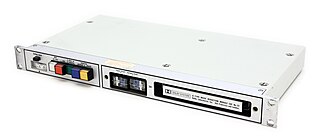 W
WA Dolby noise-reduction system, or Dolby NR, is one of a series of noise reduction systems developed by Dolby Laboratories for use in analog audio tape recording. The first was Dolby A, a professional broadband noise reduction system for recording studios in 1965, but the best-known is Dolby B, a sliding band system for the consumer market, which helped make high fidelity practical on cassette tapes, which used a relatively noisy tape size and speed. It is common on high fidelity stereo tape players and recorders to the present day. Of the noise reduction systems, Dolby A and Dolby SR were developed for professional use. Dolby B, C, and S were designed for the consumer market. Aside from Dolby HX, all the Dolby variants work by companding, or compressing, the dynamic range of the sound during recording, and expanding it during playback.
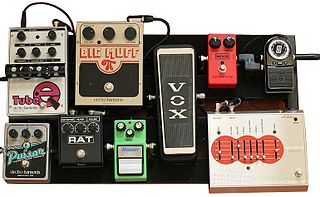 W
WAn effects unit or effects pedal is an electronic device that alters the sound of a musical instrument or other audio source through audio signal processing.
 W
WEqualization is the process of adjusting the balance between frequency components within an electronic signal. The most well known use of equalization is in sound recording and reproduction but there are many other applications in electronics and telecommunications. The circuit or equipment used to achieve equalization is called an equalizer. These devices strengthen or weaken the energy of specific frequency bands or "frequency ranges".
 W
WIn audio engineering, a fade is a gradual increase or decrease in the level of an audio signal. The term can also be used for film cinematography or theatre lighting in much the same way.
 W
WField recording is the term used for an audio recording produced outside a recording studio, and the term applies to recordings of both natural and human-produced sounds. It also applies to sound recordings like electromagnetic fields or vibrations using different microphones like a passive magnetic antenna for electromagnetic recordings or contact microphones. For underwater field recordings, a field recordist uses hydrophones to capture the sounds and/or movements of whales, or other aquatic organisms. These recordings are very useful for sound designers.
 W
WA guitar speaker is a loudspeaker – specifically the driver (transducer) part – designed for use in a combination guitar amplifier of an electric guitar, or for use in a guitar speaker cabinet. Typically these drivers produce only the frequency range relevant to electric guitars, which is similar to a regular woofer type driver, which is approximately 75 Hz — 5 kHz, or for electric bass speakers, down to 41 Hz for regular four-string basses or down to about 30 Hz for five-string instruments.
The Haeco-CSG or Holzer Audio Engineering-Compatible Stereo Generator system was an analog electronic device developed by Howard Holzer, Chief Engineer at A&M Records in Hollywood, California.
 W
WRoe Erister "Rick" Hall was an American record producer, songwriter, and musician who became known as the owner of FAME Studios in Muscle Shoals, Alabama. As the "Father of Muscle Shoals Music", he was influential in recording and promoting both country and soul music, and in helping develop the careers of such musicians as Aretha Franklin, Otis Redding, Duane Allman and Etta James.
 W
WA headphone amplifier is a low-powered audio amplifier designed particularly to drive headphones worn on or in the ears, instead of loudspeakers in speaker enclosures. Most commonly, headphone amplifiers are found embedded in electronic devices that have a headphone jack, such as integrated amplifiers, portable music players, and televisions. However, standalone units are used, especially in audiophile markets and in professional audio applications, such as music studios. Headphone amplifiers are available in consumer-grade models used by hi-fi enthusiasts and audiophiles and professional audio models, which are used in recording studios.
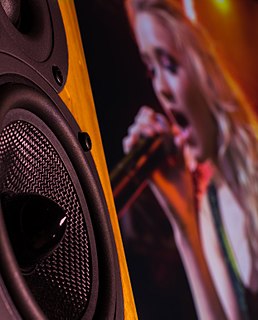 W
WHigh fidelity is a term used by listeners, audiophiles and home audio enthusiasts to refer to high-quality reproduction of sound. This is in contrast to the lower quality sound produced by inexpensive audio equipment, AM radio, or the inferior quality of sound reproduction that can be heard in recordings made until the late 1940s.
 W
WMultitrack recording of sound is the process in which sound and other electro-acoustic signals are captured on a recording medium such as magnetic tape, which is divided into two or more audio tracks that run parallel with each other. Because they are carried on the same medium, the tracks stay in perfect synchronisation, while allowing multiple sound sources to be recorded asynchronously. The first system for creating stereophonic sound was demonstrated by Clément Ader in Paris in 1881. The pallophotophone, invented by Charles A. Hoxie and first demonstrated in 1922, recorded optically on 35 mm film, and some versions used a format of as many as twelve tracks in parallel on each strip. The tracks were recorded one at a time in separate passes and were not intended for later mixdown or stereophony; as with later half-track and quarter-track monophonic tape recording, the multiple tracks simply multiplied the maximum recording time possible, greatly reducing cost and bulk. British EMI engineer Alan Blumlein patented systems for recording stereophonic sound and surround sound on disc and film in 1933. The history of modern multitrack audio recording using magnetic tape began in 1943 with the invention of stereo tape recording, which divided the recording head into two tracks.
 W
WThe history of sound recording - which has progressed in waves, driven by the invention and commercial introduction of new technologies — can be roughly divided into four main periods:The Acoustic era (1877–1925) The Electrical era (1925–1945) The Magnetic era (1945–1975) The Digital era (1975–present).
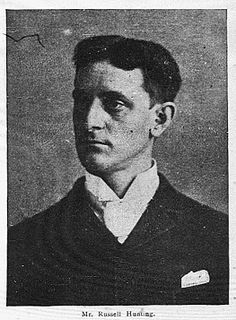 W
WRussell Dinsmore Hunting was an American comic entertainer, pioneer sound recordist, and an influential figure in the early years of the recorded music industry. He was described as "the most popular pre-1900 recording artist".
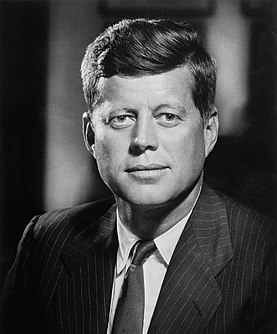 W
WThe John F. Kennedy assassination Dictabelt recording was a recording from a motorcycle police officer's radio microphone stuck in the open position that became a key piece of evidence cited by the House Select Committee on Assassinations (HSCA) in their conclusion that there was a conspiracy behind the assassination of John F. Kennedy on November 22, 1963. Made on a common Dictaphone-brand dictation machine that recorded sound in grooves pressed into a thin vinyl-plastic belt, the recording gained prominence among Kennedy assassination conspiracy theorists from 1978, in which the HSCA used it to conclude that there was a "high probability" that Lee Harvey Oswald did not act alone and that the Kennedy assassination was the result of a conspiracy.
 W
WLip sync or lip synch is a technical term for matching a speaking or singing person's lip movements with sung or spoken vocals.
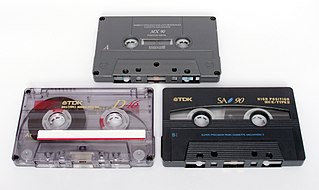 W
WPreservation of magnetic audiotape comprises techniques for handling, cleaning and storage of magnetic audiotapes in an archival repository. Multiple types of magnetic media exist but are mainly in the form of open reels or enclosed cassettes. Although digitization of materials on fragile magnetic media in library and information science is a common practice, there remains a need for conserving the actual physical magnetic tape and playback equipment as artifacts.
 W
WMagnetic tape is a medium for magnetic recording, made of a thin, magnetizable coating on a long, narrow strip of plastic film. It was developed in Germany in 1928, based on magnetic wire recording. Devices that record and playback audio and video using magnetic tape are tape recorders and video tape recorders respectively. A device that stores computer data on magnetic tape is known as a tape drive.
 W
WA microphone, colloquially called a mic or mike, is a device – a transducer – that converts sound into an electrical signal. Microphones are used in many applications such as telephones, hearing aids, public address systems for concert halls and public events, motion picture production, live and recorded audio engineering, sound recording, two-way radios, megaphones, radio and television broadcasting. They are also used in computers for recording voice, speech recognition, VoIP, and for non-acoustic purposes such as ultrasonic sensors or knock sensors.
 W
WA mult box is "a metal box with multiple outputs of a single audio source ." A mult box is sometimes called a press box, but that term is usually reserved for the sports media's section of an arena. It may also be called a press mult box or press bridge. The sound engineer connects several microphones to allow all of them to get clean, high-quality audio.
 W
WMultitrack recording (MTR), also known as multitracking or tracking, is a method of sound recording developed in 1955 that allows for the separate recording of multiple sound sources or of sound sources recorded at different times to create a cohesive whole. Multitracking became possible in the mid-1950s when the idea of simultaneously recording different audio channels to separate discrete "tracks" on the same reel-to-reel tape was developed. A "track" was simply a different channel recorded to its own discrete area on the tape whereby their relative sequence of recorded events would be preserved, and playback would be simultaneous or synchronized.
 W
WMusic technology is the study or the use of any device, mechanism, machine or tool by a musician or composer to make or perform music; to compose, notate, play back or record songs or pieces; or to analyze or edit music.
 W
WDigital music technology encompasses digital instruments, computers, electronic effects units, software, or digital audio equipment by a performer, composer, sound engineer, DJ, or record producer to produce, perform or record music. The term refers to electronic devices, instruments, computer hardware, and software used in performance, playback, recording, composition, mixing, analysis, and editing of music.
 W
WThe National Recording Preservation Plan is a strategic guide for the preservation of sound recordings in the United States. It was published in December 2012 by the Council on Library and Information Resources (CLIR) and the National Recording Preservation Board of the Library of Congress. The plan was written by a community of specialists, but is prominently credited to Brenda Nelson-Strauss, Alan Gevinson and Sam Brylawski
 W
WIn music, noise is variously described as unpitched, indeterminate, uncontrolled, loud, unmusical, or unwanted sound. Noise is an important component of the sound of the human voice and all musical instruments, particularly in unpitched percussion instruments and electric guitars. Electronic instruments create various colours of noise. Traditional uses of noise are unrestricted, using all the frequencies associated with pitch and timbre, such as the white noise component of a drum roll on a snare drum, or the transients present in the prefix of the sounds of some organ pipes.
 W
WNoise reduction is the process of removing noise from a signal. Noise reduction techniques exist for audio and images. Noise reduction algorithms tend to alter signals to a greater or lesser degree.
 W
WOptical disc packaging is the packaging that accompanies CDs, DVDs, and other formats of optical discs. Most packaging is rigid or semi-rigid and designed to protect the media from scratches and other types of exposure damage.
 W
WOptical sound is a means of storing sound recordings on transparent film. Originally developed for military purposes, the technology first saw widespread use in the 1920s as a sound-on-film format for motion pictures. Optical sound eventually superseded all other sound film technologies until the advent of digital sound became the standard in cinema projection booths. Optical sound has also been used for multitrack recording and for creating effects in some musical synthesizers.
 W
WOverhead microphones are those used in sound recording and live sound reproduction to pick up ambient sounds, transients and the overall blend of instruments. They are used in drum recording to achieve a stereo image of the full drum kit, as well as orchestral recording to create a balanced stereo recording of full orchestras.
 W
WA peak programme meter (PPM) is an instrument used in professional audio that indicates the level of an audio signal.
 W
WA phonograph, in its later forms also called a gramophone or since the 1940s called a record player, is a device for the mechanical recording and reproduction of sound. The sound vibration waveforms are recorded as corresponding physical deviations of a spiral groove engraved, etched, incised, or impressed into the surface of a rotating cylinder or disc, called a "record". To recreate the sound, the surface is similarly rotated while a playback stylus traces the groove and is therefore vibrated by it, very faintly reproducing the recorded sound. In early acoustic phonographs, the stylus vibrated a diaphragm which produced sound waves which were coupled to the open air through a flaring horn, or directly to the listener's ears through stethoscope-type earphones.
 W
WA variable speed pitch control is a control on an audio device such as a turntable, tape recorder, or CD player that allows the operator to deviate from a standard speed. The latter term "vari-speed" is more commonly used for tape decks, particularly in the UK. Analog pitch controls vary the voltage being used by the playback device; digital controls use digital signal processing to change the playback speed or pitch. A typical DJ deck allows the pitch to be increased or reduced by up to 8%, which is achieved by increasing or reducing the speed at which the platter rotates.
 W
WPitch shifting is a sound recording technique in which the original pitch of a sound is raised or lowered. Effects units that raise or lower pitch by a pre-designated musical interval (transposition) are called pitch shifters.
 W
WThe TASCAM Portastudio was the world's first four-track recorder based on a standard compact audio cassette tape. The term portastudio is exclusive to TASCAM, though it is generally used to describe all self-contained cassette-based multitrack recorders dedicated to music production. The Portastudio, and particularly its first iteration, the Teac 144, is credited with launching the home-recording wave, which allowed musicians to cheaply record and produce music at home, and is cited as one of the most significant innovations in music production technology.
 W
WPro Tools is a digital audio workstation (DAW) developed and released by Avid Technology for Microsoft Windows and macOS used for music creation and production, sound for picture and, more generally, sound recording, editing, and mastering processes.
 W
WProducing Great Sound for Film and Video: Expert Tips from Preproduction to Final Mix is a non-fiction book and filmmaking handbook. The book is also used as a university textbook. It covers the process of acquiring professional quality sound for motion picture productions.
 W
WA production sound mixer, location sound recordist, location sound engineer, or simply sound mixer is the member of a film crew or television crew responsible for recording all sound recording on set during the filmmaking or television production using professional audio equipment, for later inclusion in the finished product, or for reference to be used by the sound designer, sound effects editors, or foley artists. This requires choice and deployment of microphones, choice of recording media, and mixing of audio signals in real time.
 W
WSound recording and reproduction is an electrical, mechanical, electronic, or digital inscription and re-creation of sound waves, such as spoken voice, singing, instrumental music, or sound effects. The two main classes of sound recording technology are analog recording and digital recording.
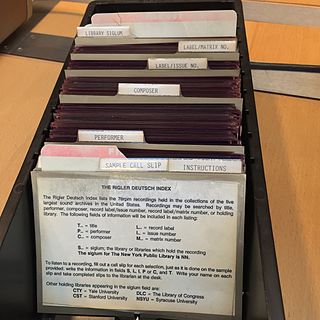 W
WThe Rigler and Deutsch Index of Recorded Sound, also known as the Rigler Deutsch Index, is a union catalog collocation of the U.S. holdings of 78 rpm records in the collections of the Library of Congress Motion Picture, Broadcasting, and Recorded Sound Division; the Rodgers and Hammerstein Archives of Recorded Sound at the New York Public Library; Belfer Audio Laboratory and Archive at Syracuse University; the Yale Collection of Historical Sound Recordings at Yale University; and the Stanford Archive of Recorded Sound at Stanford University.
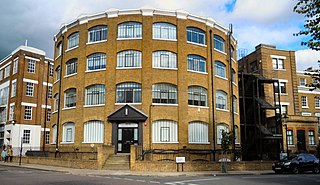 W
WSpirit Studios, formerly known as SSR and The School of Sound Recording, is a music and media training academy producing graduates within the music, television, film and radio industries. It is based in Manchester in northern England, and has offshoots in London and Jakarta.
 W
WSpill is the occurrence in sound recording and live sound mixing whereby sound is picked up by a microphone from a source other than that which is intended. Spill is usually seen as a problem, and various steps are taken to avoid it or reduce it. In some styles of music, such as orchestral music, jazz, and blues, it is more likely to be accepted or even seen as desirable.
 W
WStereophonic sound or, more commonly, stereo, is a method of sound reproduction that creates an illusion of multi-directional audible perspective. This is usually achieved by using two or more independent audio channels through a configuration of two or more loudspeakers in such a way as to create the impression of sound heard from various directions, as in natural hearing. Thus the term "stereophonic" applies to so-called "quadraphonic" and "surround-sound" systems as well as the more common two-channel, two-speaker systems. It is often contrasted with monophonic, or "mono" sound, where audio is heard as coming from one position, often ahead in the sound field. Stereo sound has been in common use since the 1970s in entertainment systems such as broadcast radio, TV, recorded music, internet, computer audio, and cinema.
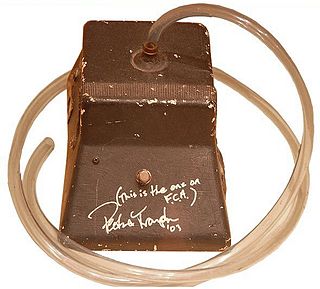 W
WA talk box is an effects unit that allows musicians to modify the sound of a musical instrument by shaping the frequency content of the sound and to apply speech sounds onto the sounds of the instrument. Typically, a talk box directs sound from the instrument into the musician's mouth by means of a plastic tube adjacent to their vocal microphone. The musician controls the modification of the instrument's sound by changing the shape of the mouth, "vocalizing" the instrument's output into a microphone.
 W
WAn audio tape recorder, tape deck, or tape machine is a sound recording and reproduction device that records and plays back sounds usually using magnetic tape for storage. In its present-day form, it records a fluctuating signal by moving the tape across a tape head that polarizes the magnetic domains in the tape in proportion to the audio signal. Tape-recording devices include the reel-to-reel tape deck and the cassette deck, which uses a cassette for storage.
 W
WA taper is a person who records musical events, often from standing microphones in the audience, for the benefit of the musical group's fanbase. Such taping was popularized in the late 1960s and early 1970s by fans of the Grateful Dead. Audio recording, while not officially allowed until the creation by the band of a "tapers' section" behind the soundboard in the mid-1980s, was generally tolerated at shows and fans would share their tapes through trade. Taping and trading became a Grateful Dead sub-culture.
 W
WVintage musical equipment is older music gear, including instruments, amplifiers and speakers, sound recording equipment and effects pedals, sought after, maintained and used by record producers, audio engineers and musicians who are interested in historical music genres. While any piece of equipment of sufficient age can be considered vintage, in the 2010s the term is typically applied to instruments and gear from the 1970s and earlier. Guitars, amps, pedals, electric keyboards, sound recording equipment from the 1950s to 1970s are particularly sought. Musical equipment from the 1940s and prior eras is often expensive, and sought out mainly by museums or collectors.
 W
WThe Volta Laboratory and the Volta Bureau were created in Georgetown, Washington, D.C. by Alexander Graham Bell.
 W
WXDR, also known as SDR is a quality-control and duplication process for the mass-production of pre-recorded audio cassettes. It is a process designed to provide higher quality audio on pre-recorded cassettes by checking the sound quality at all stages of the tape duplication process. In this way, the dynamic range of audio recorded on an XDR-duplicated cassette can be up to 13 decibels greater.